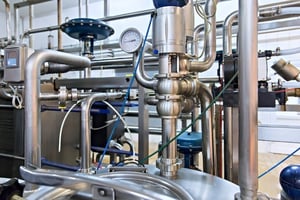Selecting the correct valve for your pumping system is critical for optimal performance,...
How to Size Control Valves and Why It's Important

Control valves play a vital role in a range of industrial processes, ensuring the smooth flow of fluids like gases, steam, water, or chemicals to maintain peak performance and safety standards. Getting the sizing of control valves right is key to maximizing efficiency, preventing mishaps, and cutting down on operational expenses. Keep on reading to learn about the significance of control valve sizing and why it truly matters.
Before diving into the specifics of sizing, let's understand why it is important:
- Efficiency: An appropriately sized control valve ensures the system operates at its best efficiency, minimizing energy consumption and operational costs.
- Control: Proper sizing allows for precise control over the flow rate, ensuring that the process remains within desired parameters.
- Safety: Incorrectly sized valves can lead to unsafe operating conditions, potentially causing overpressure situations or insufficient flow rates.
- Longevity: A well-sized valve reduces wear and tear, extending the lifespan of both the valve and the overall system.
- Cost Savings: Avoiding oversizing or under sizing can save costs related to maintenance, repairs, and energy consumption.
Steps to Size a Control Valve
-
Understand the Process Requirements: Gather detailed information about the process, including the type of fluid, flow rates, temperature, pressure conditions, and any specific process requirements.
-
Determine Flow Coefficient (Cv): The flow coefficient (Cv) is a critical parameter in valve sizing. It indicates the valve's capacity to pass a specific flow rate under a given pressure drop.
-
Select the Valve Type: Choose the appropriate valve type based on the application, fluid characteristics, and desired control action. Common types include globe valves, ball valves, butterfly valves, and diaphragm valves.
-
Consider the Valve Characteristics: Evaluate the valve's inherent flow characteristics, such as linear, equal percentage, or quick opening. The choice depends on how the flow rate changes with the valve position.
-
Check the Valve's Rangeability: Rangeability is the ratio of the maximum to the minimum controllable flow rate. Ensure the selected valve can handle the required flow range effectively.
-
Perform Sizing Calculations: Use the Cv value, process parameters, and valve characteristics to perform detailed sizing calculations. Manufacturers often provide software tools or sizing charts to assist in this step.
-
Verify with Manufacturer's Specifications: Cross-check the calculated sizing with the valve manufacturer's specifications to ensure compatibility and performance.
-
Consider Environmental and Regulatory Factors: Take into account any environmental conditions (e.g., temperature extremes, corrosive environments) and regulatory requirements that might affect valve performance and selection.
Expert Assistance
Properly sizing a control valve is essential for efficient, safe, and cost-effective operation of industrial processes. By following a systematic approach to sizing, you can ensure optimal performance, extend equipment lifespan, and minimize operational costs. However, valve sizing can be complex and requires expertise to get it right.
Our experienced team is here to help. With in-depth knowledge and industry experience, we can assist you in selecting and sizing the perfect control valve for your specific needs. Don't hesitate to contact us for expert advice and support in sizing your valves. Trust our expertise to ensure your processes run smoothly and efficiently



